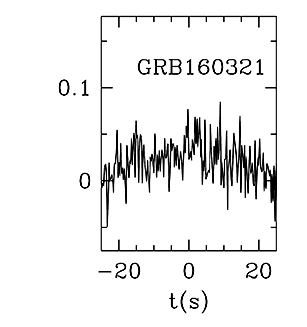GRB 160321A
Time: 15:55:27
Trigger Number: 680017
Burst Advocate: Mike Stamatikos
BAT Data:
| RA: a | 99.420 06:37:40.8 |
| Dec: a | 5.753 05:45:10.8 |
| 90% Error Radius: b | 1.6 |
| T90: c | 33.6 |
| Fluence: d | 5.3 (0.7) |
| 1s Peak Photon Flux: e | 0.5 (0.1) |
| Photon Index: f | 1.89, PL (0.19) |
90% error in parentheses,
a J2000;
b arcmin;
c seconds;
d 10-7 erg/cm2 (15-150 keV);
e ph/cm2/sec (15-150 keV);
f PL = simple power-law, CPL = cutoff power-law (15-150 keV)
BAT Light Curve:

XRT Data:
| RA: a | 06:37:40.77 |
| Dec: a | 05:44:51.8 |
| 90% Error Radius: b | 1.5 |
| Time to First Observation: c | 110.89 |
| Early Flux: d | n/a |
| 11 Hour Flux: d | 0.00005016252 |
| 24 Hour Flux: d | 0.0000079619835 |
| Initial Temporal Index: | -2.359 |
| Spectral Index (Gamma): | 1.44922 |
| Column Density (NH): e | 9.28936 |
Note: Please be aware that only the very basic temporal and spectral quantities are reported here. You are strongly encouraged to see the referenced GCN circulars for full details.
a J2000;
b arcsec;
c seconds;
d 10-11 erg/cm2/s (0.3-10 keV);
e 1021 cm-2
» XRT GRB Live Catalogue
» XRT Light Curves
» XRT Spectra
UVOT Data:
| RA: a | n/a |
| Dec: a | n/a |
| 90% Error Radius: b | n/a |
| Time to First Observation: c | 115 |
| V Magnitude: | V>19.5 |
| Other Filter Magnitudes: | B>20.1 U>20.1 UVW1>20.2 UVM2>20.1 UVW2>19.7 White>21.1 |
a J2000; b arcsec; c seconds
Other Burst Info:
Redshift:Host Galaxy:
Other Observatory Detections:
HJT (1.5m)
Comments:
BAT: Based on the ground analysis result, this event is very likely a GRB. However, given that it is on the Galactic Plane (lat = -0.43 deg.), we cannot rule out a galactic origin.
UVOT: no detection
References:
BAT: GCN 19211; GCN 19216
XRT: GCN 19211; GCN 19213; GCN 19215; Evans et al., 2009, MNRAS, 397, 1177
UVOT: GCN 19211; GCN 19217
Radio:
Redshift:
Host:
Other:
